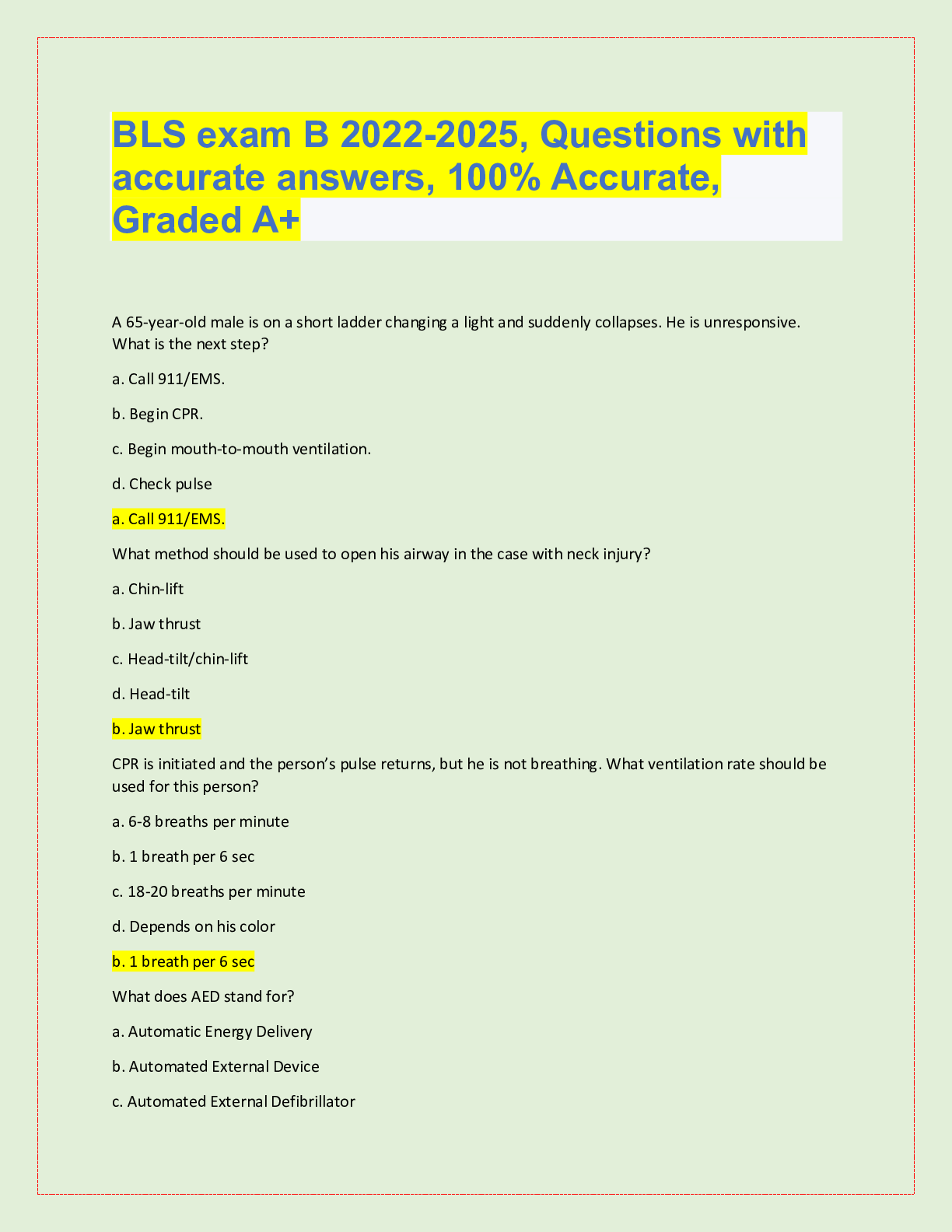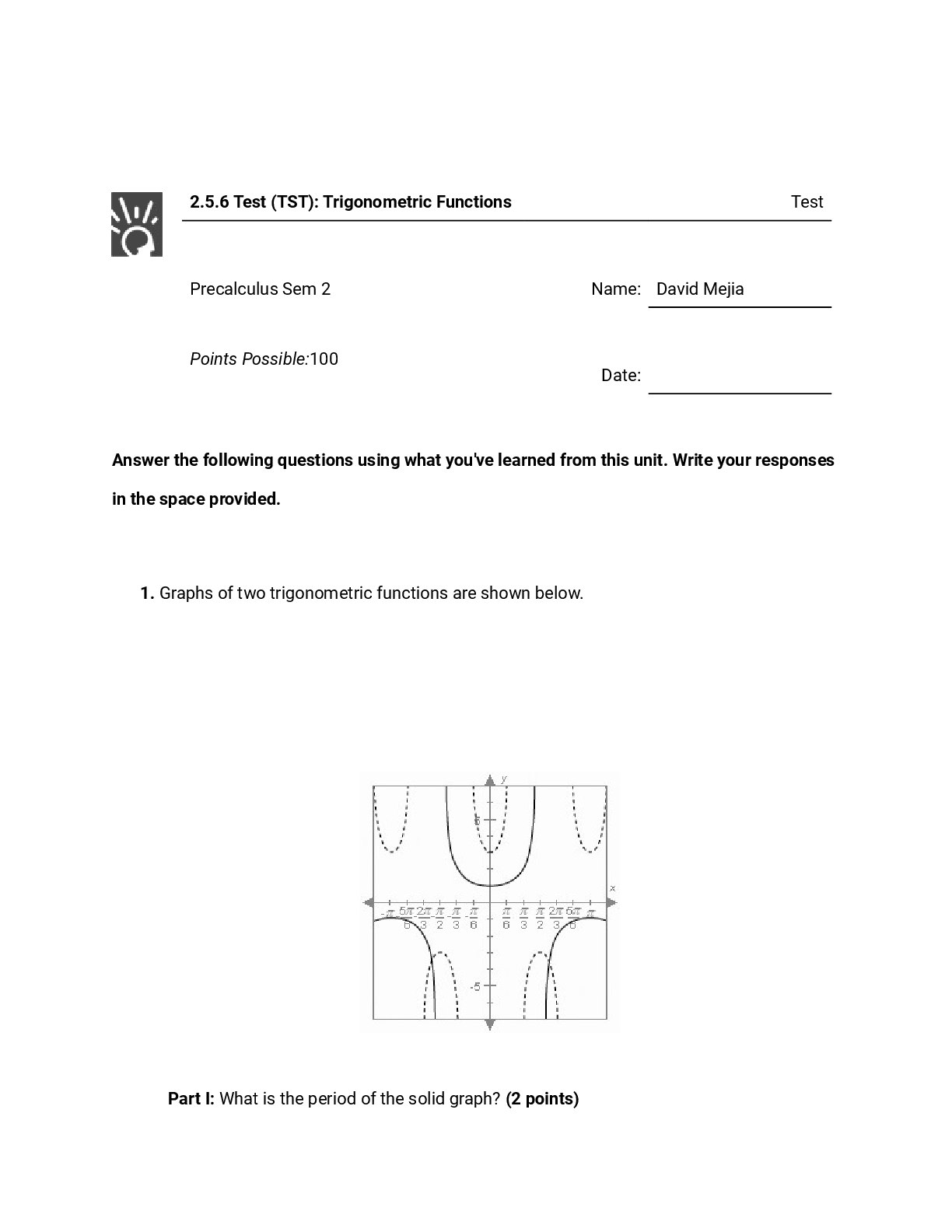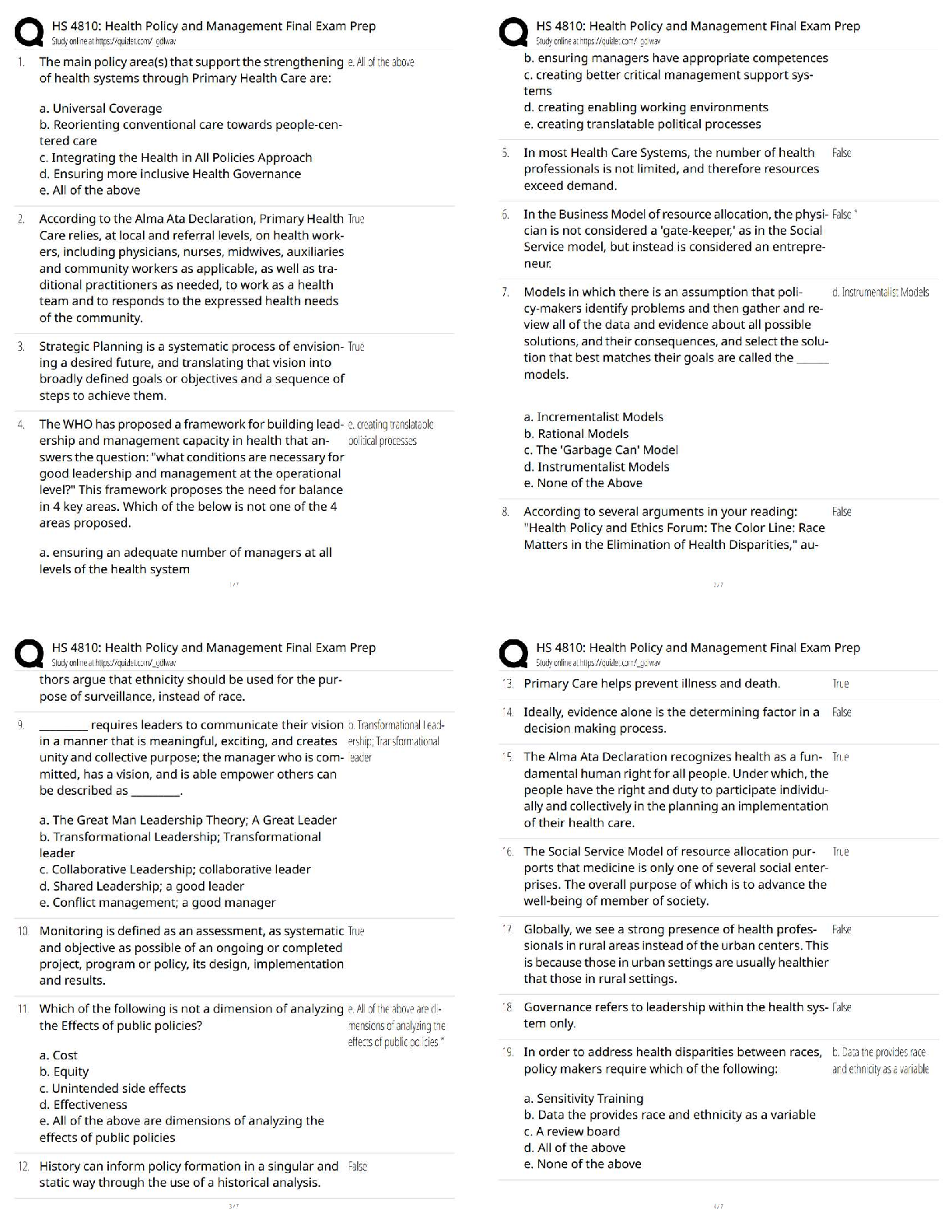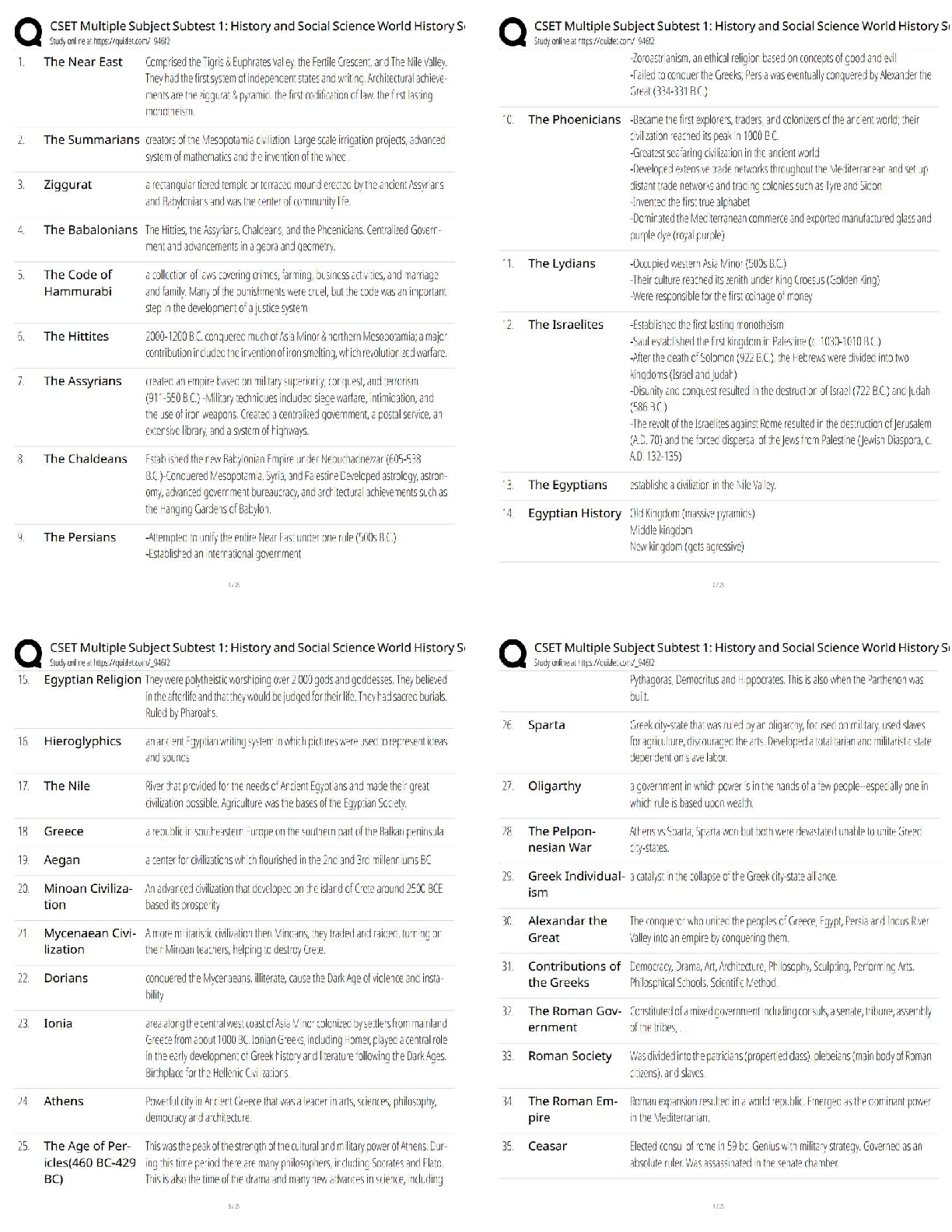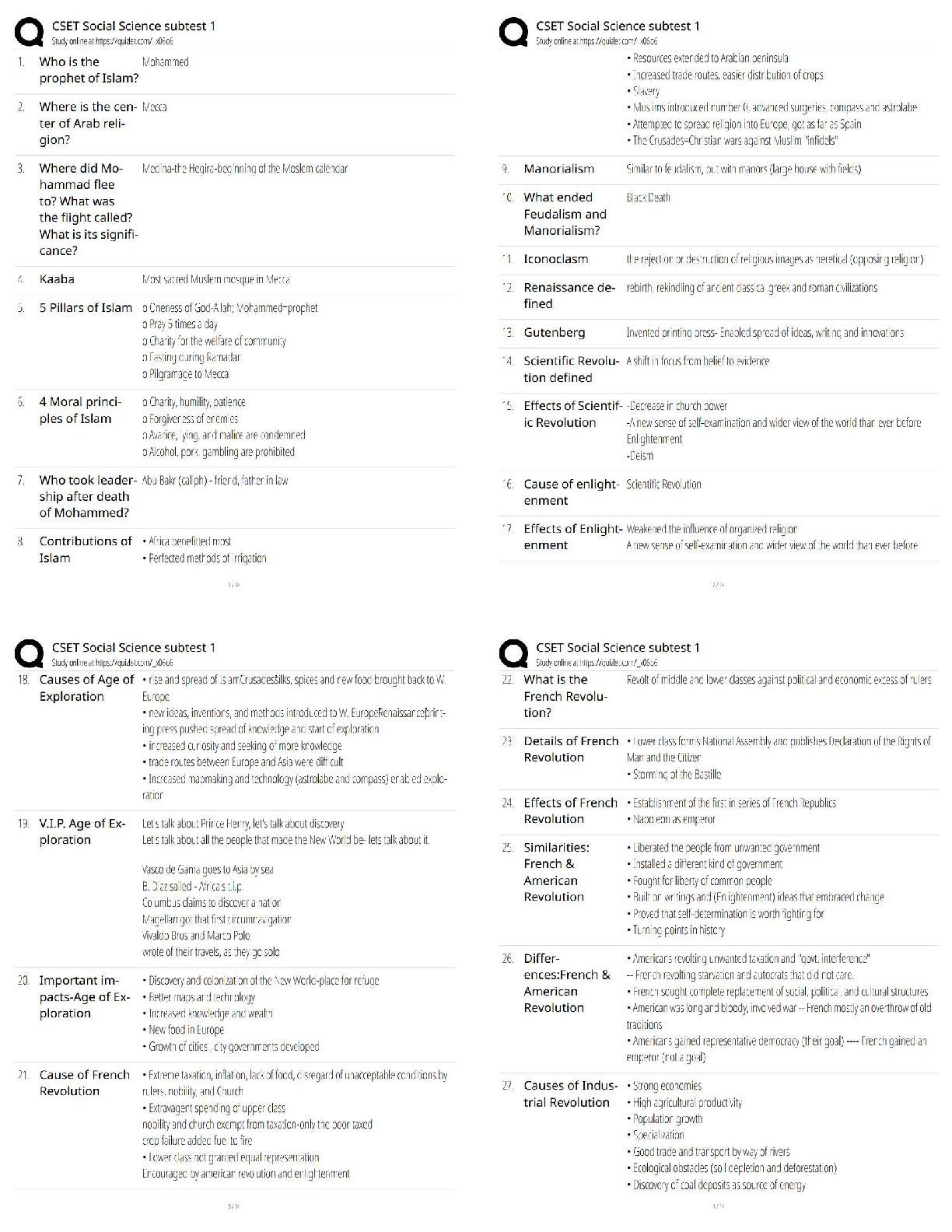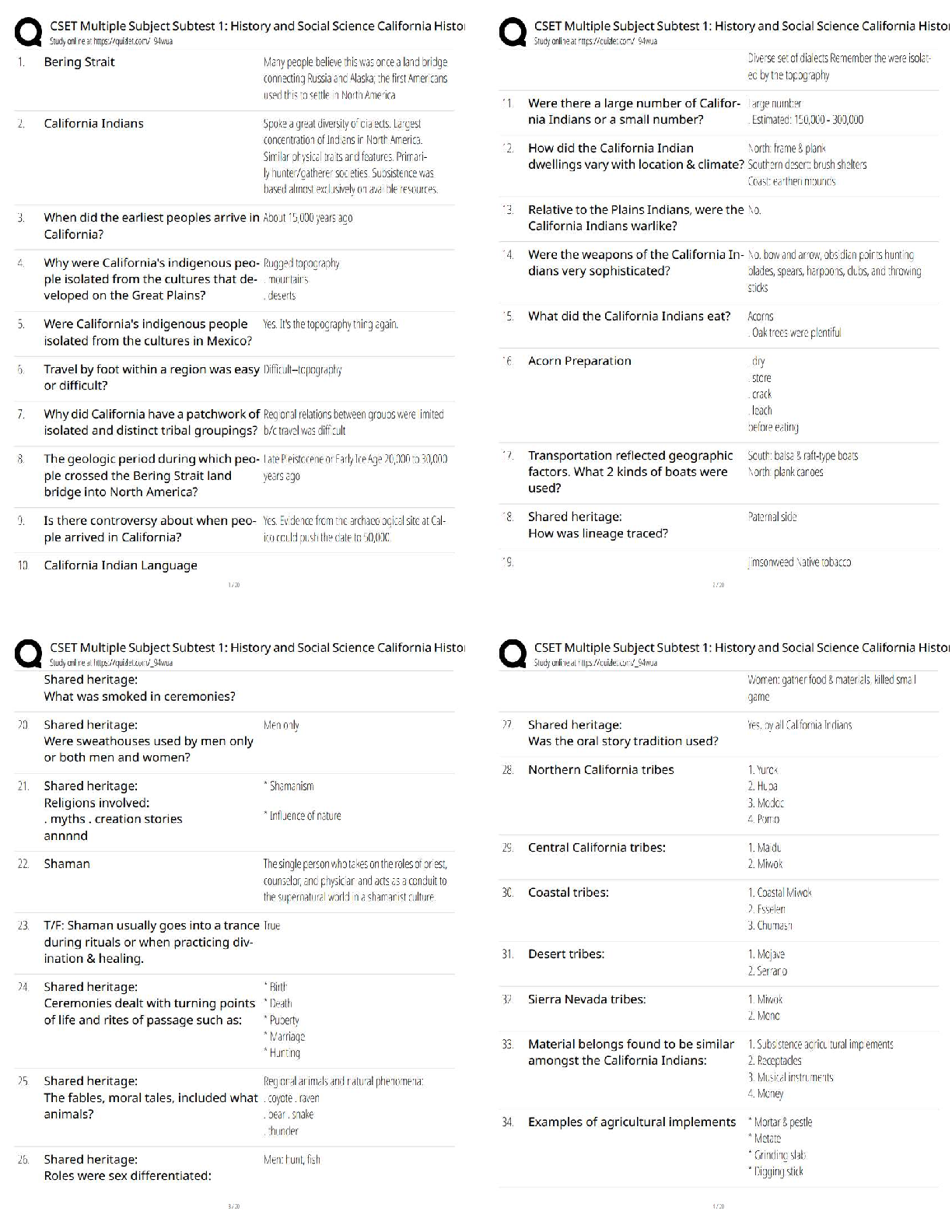Education > QUESTIONS & ANSWERS > MTTC 106 Practice Test Questions with accurate answers, rated A+. Verified. (All)
MTTC 106 Practice Test Questions with accurate answers, rated A+. Verified.
Document Content and Description Below
MTTC 106 Practice Test Questions with accurate answers, rated A+. Verified. Seven-year-old Selina, a student with a cognitive impairment, attends a first-grade class. She lives with her parents a ... nd two older sisters. Every morning, as Selina's family prepares to go to work or school, one of Selina's sisters dresses her, combs her hair, and brushes her teeth. Which of the following characteristics or attitudes would Selina be most likely to develop as a result of this daily routine? social anxiety a sense of entitlement learned helplessness a lack of empathy - ✔✔-learned helplessness A six-month-old child in an infant and toddler program has been recently diagnosed with a significant hearing loss. According to scientifically based research, which of the following strategies would be the most effective for promoting this child's language development? always speaking loudly and slowly when talking to the child using exaggerated lip movements to foster the child's speechreading immediately starting to use sign language with the child making pictures for the child to point to to indicate his or her needs - ✔✔-immediately starting to use sign language with the child Five-year-old John has been enrolled in a kindergarten class partway through the school year. On his first day at school, John chooses to play in the block center. John first spends a few minutes watching what two of his new classmates are building, then sits down near them and starts making a road. After a few more minutes, John says to the children, "Hey, we could connect my road to your road. Look." One of the other children says, "Yeah, then we could make a really, really long road around the city!" Soon all three children are working busily on the road. John's behavior in this situation best demonstrates how: proficiency in social skills can facilitate communication and collaborative thinking. the ability to self-regulate can facilitate interpersonal problem solving and conflict resolution. a positive disposition toward learning can facilitate growth across multiple developmental domains. perseverance in completing tasks can facilitate children's development of a sense of self-esteem. - ✔✔- proficiency in social skills can facilitate communication and collaborative thinking. Which of the following children is demonstrating behavior that is atypical of a three-year-old child? Katya draws figures that resemble circles. Tranh covers a page with scribbles and announces that it's a grocery list. Gwen has difficulty holding and cutting with scissors. Jonah draws detailed pictures of his mother with specific facial features. - ✔✔-Jonah draws detailed pictures of his mother with specific facial features. Ava is a four-year-old child who has Down syndrome. In which of the following areas would Ava be likely to have the most significant developmental delay? social learning spatial processing visual memory speech production - ✔✔-speech production Ms. Cohen, a preschool teacher, is preparing for the upcoming school year. This year's class will include Warren, a child who has Down syndrome. As she plans for the first weeks of school, Ms. Cohen should be aware that Warren is especially likely to benefit from learning activities that: involve whole-class instruction. emphasize auditory processing. begin with a conceptual overview. incorporate visual cues. - ✔✔-incorporate visual cues. Five-year-old Silvio, a student with spina bifida, will be attending a general education preschool class in the upcoming year. Silvio uses a power wheelchair, which he propels independently. Which of the following issues would be especially important for Silvio's preschool teacher to be aware of in order to promote Silvio's health and physical well-being in the classroom? checking Silvio's wheelchair thoroughly for proper function on Monday of each week ensuring that Silvio's pressure relief regimen is followed everyday without fail isolating Silvio whenever one or more of his classmates shows any signs of illness confirming each day that Silvio has been administered his required daily medications - ✔✔-ensuring that Silvio's pressure relief regimen is followed everyday without fail A prekindergarten teacher who works in an inclusive setting wishes to create a learning environment that promotes children's independence in the classroom. Which of the following strategies would likely be most effective for the teacher to use to achieve this goal? having children participate in putting away their toys and materials providing opportunities for children to make choices about activities and tasks each school day incorporating instructional themes that build on children's interests encouraging children to work alone on activities and tasks rather than with a classmate - ✔✔-providing opportunities for children to make choices about activities and tasks each school day Six-year-old Noah is a student with autism spectrum disorder who attends Ms. Wu's first-grade class. Ms. Wu has created a visual schedule with Noah to help him learn the daily classroom routine; however, Noah has difficulty when anything out of the ordinary happens. For example, during a recent unannounced fire drill, he began shouting and pulling his hair. Ms. Wu is aware that the class will be attending an assembly later in the week during a time regularly scheduled for mathematics instruction. Which of the following strategies would likely be most effective for Ms. Wu to use to help Noah with this change in the schedule? assigning Noah to sit with a peer who can model good behavior for him during the assembly talking to Noah about the assembly well ahead of time and adding pictures to his visual schedule to illustrate the change arranging for a paraprofessional to stay with Noah in the classroom during the assembly and work with him on mathematics skills contacting Noah's parents about the assembly and requesting that they keep him home from school that day - ✔✔-talking to Noah about the assembly well ahead of time and adding pictures to his visual The outdoor play area at an early childhood center has a play structure that consists of three swings, two slides, a climbing wall, and a play deck. Several times this week, there have been arguments among a class of four-year-olds regarding who can use the swings. The teacher wishes to use this as an opportunity to help children develop conflict-resolution skills. Which of the following steps should the teacher take first to address this goal? reminding children that they need to take turns using the swings and other parts of the play structure posting a sign-up sheet for children to use to sign up for time on the swings during outdoor play conducting a class meeting and helping children define what the problem is with the swings providing other types of equipment such as balls and bubbles for children to use rather than the swings - ✔✔-conducting a class meeting and helping children define what the problem is with the swings A comprehensive evaluation is being planned for Annika, an eight-month-old child who has consistently shown delays in meeting developmental milestones. For example, by seven months of age Annika had not yet rolled over. Now at eight months, Annika does not reach for objects and has poor head control when pulled from her back to a sitting position. During the evaluation, which of the following guidelines should most likely be followed? Annika's parents/guardians should remain outside the testing room. The evaluation should be conducted in 10-minute segments, with breaks in between. Annika's parents/guardians shold be asked to provide props to use during the assessment. The evaluation should be administered in Annika's natural environment. - ✔✔-The evaluation should be administered in Annika's natural environment. Two-year-old Shawna is enrolled in an early childhood program. Her teacher, Ms. Torres, is planning to conduct a developmental assessment of Shawna in order to plan effective programming for her. Which of the following steps should Ms. Torres take first in conducting this assessment? talking to Shawna about her interests to measure her general level of functioning reviewing Shawna's medical records to evaluate her present physical health providing Shawna with a standardized assessment to determine her learning style meeting with Shawna's parents to discuss her current strengths and needs - ✔✔-meeting with Shawna's parents to discuss her current strengths and needs A second-grade teacher plans to develop an assessment to measure a student's attainment of a lesson objective. The teacher's first step in this process should be to: identify the most appropriate staff member to administer the assessment. determine whether the assessment should take place in the classroom or in a testing room. review the learning standard to which the assessment should be linked. investigate whether a standardized assessment exists that could be used for this purpose. - ✔✔-review the learning standard to which the assessment should be linked. After conducting a series of systematic observations in the outdoor play area, a preschool teacher becomes concerned that many children do not engage in large muscle activities even though the daily schedule provides ample opportunities for outdoor play. Which of the following strategies would be most effective for the preschool teacher to use in addressing this concern? having children run once around the play area at the beginning of outdoor play time planning noncompetitive physical games and activities in response to the data obtained assigning children to teams and awarding points based on each team's performance removing any toys in the outdoor play area that encourage sedentary or solitary play - ✔✔-planning noncompetitive physical games and activities in response to the data obtained A preschool teacher often uses observations to gain information about how individual children in his class are progressing. A significant benefit of using observations to assess preschool children is that observations: intrude minimally into children's activities. yield highly objective results. require minimal time to conduct and analyze. ensure valid comparisons between children. - ✔✔-intrude minimally into children's activities. A prekindergarten teacher notices that Lisa, a child with a physical impairment, tends to be shy and often draws by herself in the art center during free-choice time. The teacher would like to promote Lisa's greater interaction with peers. Which of the following strategies would likely be most effective? asking Lisa during circle time to talk about her favorite drawings and why she likes them drawing with Lisa in the art center and inviting a peer to join them encouraging Lisa to join her classmates in the dramatic play area suggesting that Lisa take home art supplies so that she can choose other activities during free time - ✔✔-drawing with Lisa in the art center and inviting a peer to join them Two early childhood teachers will be caring for several infants at a child-care center. The teachers would like to foster the infants' attachment and sense of security. Which of the following practices should the teachers use to address this goal? providing opportunities for the infants to interact with one another throughout the day playing soothing music in the background whenever infants are awake assigning each infant to one of the teachers who will serve as his or her primary caregiver providing each infant with regularly scheduled floor time - ✔✔-assigning each infant to one of the teachers who will serve as his or her primary caregiver Cathy, an eight-year-old student with an emotional impairment, attends Ms. Guarini's general education second-grade class. Transitions between activities are difficult for Cathy. She often reacts to them angrily, yelling or crying and refusing to stop what she is doing. Cathy's special education teacher has been helping her develop effective transitioning skills, and Ms. Guarini has been reinforcing these skills in the classroom. Which of the following additional strategies would likely be most effective for Ms. Guarini to use to help Cathy with this issue? imposing a negative consequence whenever Cathy resists making a transition permitting Cathy to choose between two new activities when she transitions cooperatively establishing a cue to alert Cathy five minutes before a transition is due to occur reminding Cathy when she arrives at school that she should prepare herself for transitions - ✔✔- establishing a cue to alert Cathy five minutes before a transition is due to occur A preschool teacher has planned a new art activity in which the children will create pictures by dipping shaped sponges into paint and then pressing them onto construction paper. The teacher wants to ensure that four-year-old Cheung, a child with a cognitive impairment, will be able to participate in this activity. Which of the following strategies would likely be most effective for this purpose? assigning the children to work on the project in groups, with each child playing a specific role creating a chart of step-by-step directions and posting it where Cheung can refer to it having all students create their pictures one step at a time, as the teacher calls out the steps arranging for Cheung to work with a peer helper who can provide guidance or assistance as necessary - ✔✔-arranging for Cheung to work with a peer helper who can provide guidance or assistance as necessary Four-year-old Lena, a child with fetal alcohol syndrome (FAS), attends Ms. Johnson's general education prekindergarten class. Lena faces a number of challenges, including problems with boundaries, difficulty interpreting social cues, and poor problem-solving skills. She is also distractible and often irritable. Lena's classmates frequently complain about her to Ms. Johnson and avoid her as much as possible. Ms. Johnson wants to create an environment that will help Lena and her classmates develop more positive attitudes and interactions towards each other. Which of the following is a key strategy that Ms. Johnson should make sure to include as one element in her effort to achieve this objective? imposing consequences immediately in response to misbehavior by any child in the class providing a quiet area for Lena to retreat to and reducing environmental stimulation arranging for the assignment of a paraprofessional to mediate Lena's social interactions eliminating special events such as field trips or guest presentations from the class schedule - ✔✔- providing a quiet area for Lena to retreat to and reducing environmental stimulation Five-year-old Jonathan, a preschooler with autism spectrum disorder (ASD), has trouble engaging in pretend play. Which of the following strategies would likely be most effective in helping him participate successfully in pretend-play activities with his classmates? leading him to the dramatic play area and sitting with him to offer guidance in how to respond as play scenarios are developed by other children prompting him to invent a play scenario for the teacher to draw in a booklet, then encouraging him to initiate the scenario in the dramatic play area giving him systematic instruction and practice in a simple play sequence that he can follow in the dramatic play area with the help of a picture script explaining to him what dramatic play is, then having him watch his classmates in the dramatic play area, and then encouraging him to join in - ✔✔-giving him systematic instruction and practice in a simple play sequence that he can follow in the dramatic play area with the help of a picture script A prekindergarten class includes a number of English language learners who speak the same first language. The teacher learns some basic expressions in the children's first language and uses them on a regular basis. The teacher also keeps some books written in the children's first language in the classroom library and regularly asks the children to share words and phrases from their first language with the class. Which of the following statements provides the primary rationale for these strategies? Knowledge of academic concepts in the first language fosters English language learners' proficiency in academic English. Early exposure to different languages facilitates all students' development of effective communication skills. Continued first-language development enhances English language learners' acquisition of English. Experience with multicultural materials promotes all students' interest and engagement in learning. - ✔✔-Continued first-language development enhances English language learners' acquisition of English. A teacher has read a favorite storybook to a small group of kindergartners several times. The teacher could use the story most effectively to foster the children's expressive language development by: asking them to respond to literal comprehension questions about the story. leading them in a group discussion about their favorite characters in the story. guiding them in creating oral sentences using key vocabulary words from the story. teaching them songs and/or nursery rhymes that relate to the theme of the story. - ✔✔-leading them in a group discussion about their favorite characters in the story. Max, a 30-month-old child who has Down syndrome, receives Early Intervention Services (EIS) in a general infant and toddler classroom. Max has limited communication, and he becomes very frustrated when he is unable to communicate what he wants (e.g., a certain toy, a particular food). Which of the following methods would likely be most effective in promoting Max's ability to communicate his needs? presenting him with multiple modes for naming his favorite items, including sign language and picture symbols instructing him in how to pantomime or act out the specific items that are most important to him asking him simple "yes" or "no" questions to which he can reply either verbally or by nodding or shaking his head providing him with intensive verbal tutoring in naming the specific items he wants most often - ✔✔- presenting him with multiple modes for naming his favorite items, including sign language and picture symbols Jamal, a four-year-old child in a preschool class, has expressive and receptive language delays. His preschool teacher is considering how best to promote Jamal's expressive language development in the classroom. Which of the following strategies by the teacher would likely be most effective for this purpose? conversing with Jamal regularly as he engages in favorite activities at school asking Jamal one or two simple questions every morning during circle time assigning Jamal a classroom helper job that requires obtaining information from his classmates encouraging Jamal to bring a favorite toy to school to play with - ✔✔-conversing with Jamal regularly as he engages in favorite activities at school The parents of an 18-month-old toddler tell the teacher they are worried because their child's expressive language seems delayed compared to that of several other children in the class. Which of the following would be the most appropriate initial response for the teacher to give in this situation? meeting with the parents to discuss their concerns and provide information about the wide variation in language development among children of this age suggesting to the parents that they increase the number of play dates their child has with age-mates encouraging the parents to schedule an appointment with a pediatrician for the specific purpose of examining the child's speech and hearing development asking the parents to evaluate the amount of time they spend talking and playing with their child each day - ✔✔-meeting with the parents to discuss their concerns and provide information about the wide variation in language development among children of this age A preschool teacher watches as Thomas, a four-year-old with a cognitive impairment, picks up an alphabet book in the class library center. Thomas sits down with the book in his lap, opens it, and begins uttering a combination of words and nonsense sounds as he turns the pages. The teacher sits down beside Thomas. Which of the following would be the teacher's best response to the reading-like behavior that Thomas is exhibiting? helping Thomas turn the pages one-by-one and prompting him to say each letter name commenting that Thomas is reading a book and talking with him about the pictures on the pages explaining that Thomas's name begins with a T and helping him find the page for that letter pointing occasionally at a specific word on a page and identifying that word for Thomas - ✔✔- commenting that Thomas is reading a book and talking with him about the pictures on the pages A prekindergarten teacher helps each child think of an animal (e.g., seal) and identify the first sound in the animal's name. The teacher then helps each child create a two-word alliteration, using the name of the animal and a verb that begins with the same letter (e.g., seals swim). Finally, the children take turns acting out their alliterations while the class tries to guess the alliteration. This activity best demonstrates the teacher's understanding of how to: create a literacy-rich learning environment for children. use word play to support children's early literacy development. promote children's perception of themselves as literate beings. encourage children to express themselves in a wide variety of modes. - ✔✔-use word play to support children's early literacy development. Which of the following words would be most appropriate to teach first graders as a sight word? know fire drink pain - ✔✔-know Daniel is a second-grade student who is able to comprehend grade-level fiction texts with relative ease. However, he is having significant difficulty comprehending a nonfiction article about the U.S. Constitution in a magazine for children. When determining the source of Daniel's difficulty, the teacher should consider which of the following questions first? Does the article use engaging language and other rhetorical devices to capture the reader's attention? Does Daniel have a learning disability that affects his ability to comprehend informational texts? Does the article contain fewer visual and textual clues to its meaning than do fiction texts? Does Daniel have sufficient background knowledge related to the content of the article? - ✔✔-Does Daniel have sufficient background knowledge related to the content of the [Show More]
Last updated: 2 years ago
Preview 1 out of 72 pages
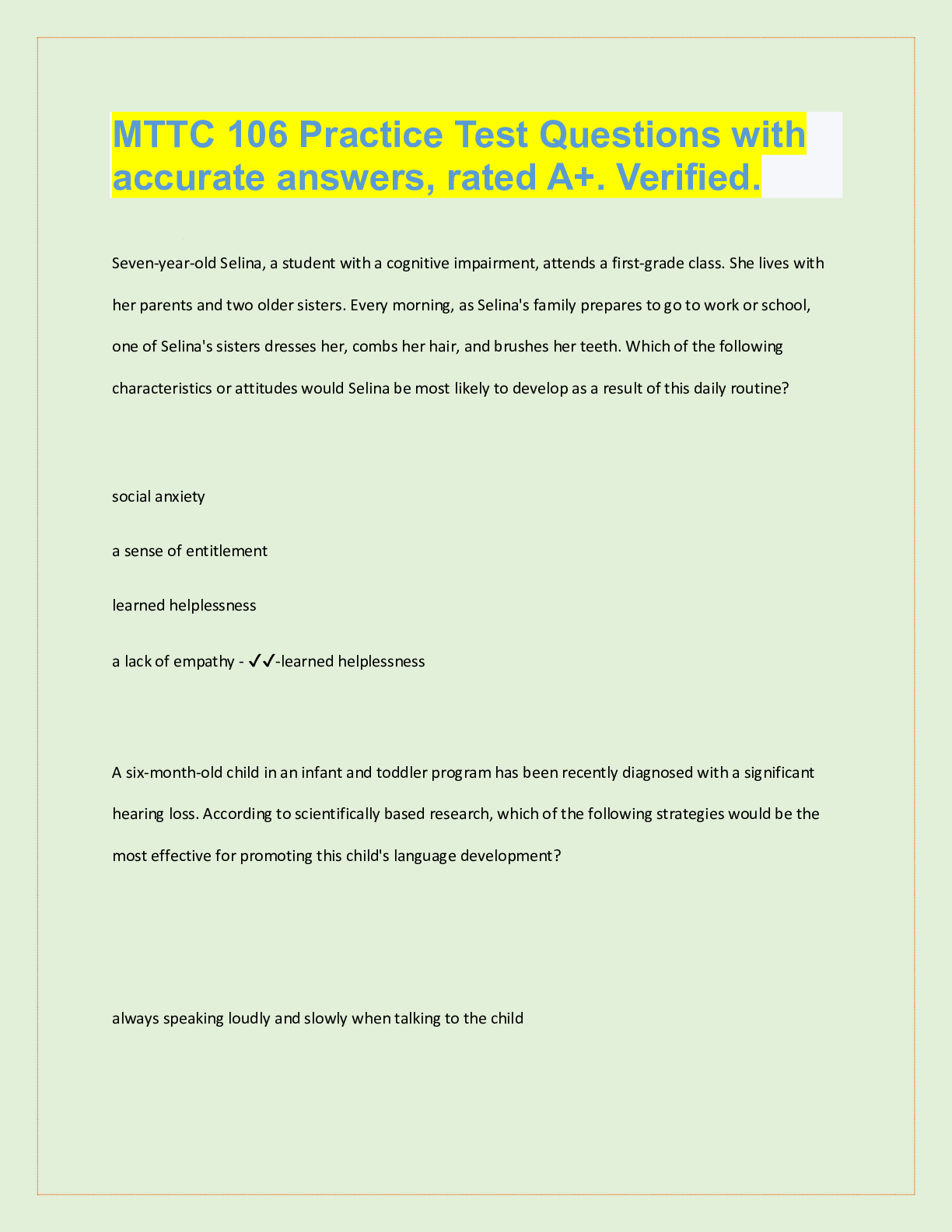
Buy this document to get the full access instantly
Instant Download Access after purchase
Buy NowInstant download
We Accept:

Also available in bundle (1)
Click Below to Access Bundle(s)
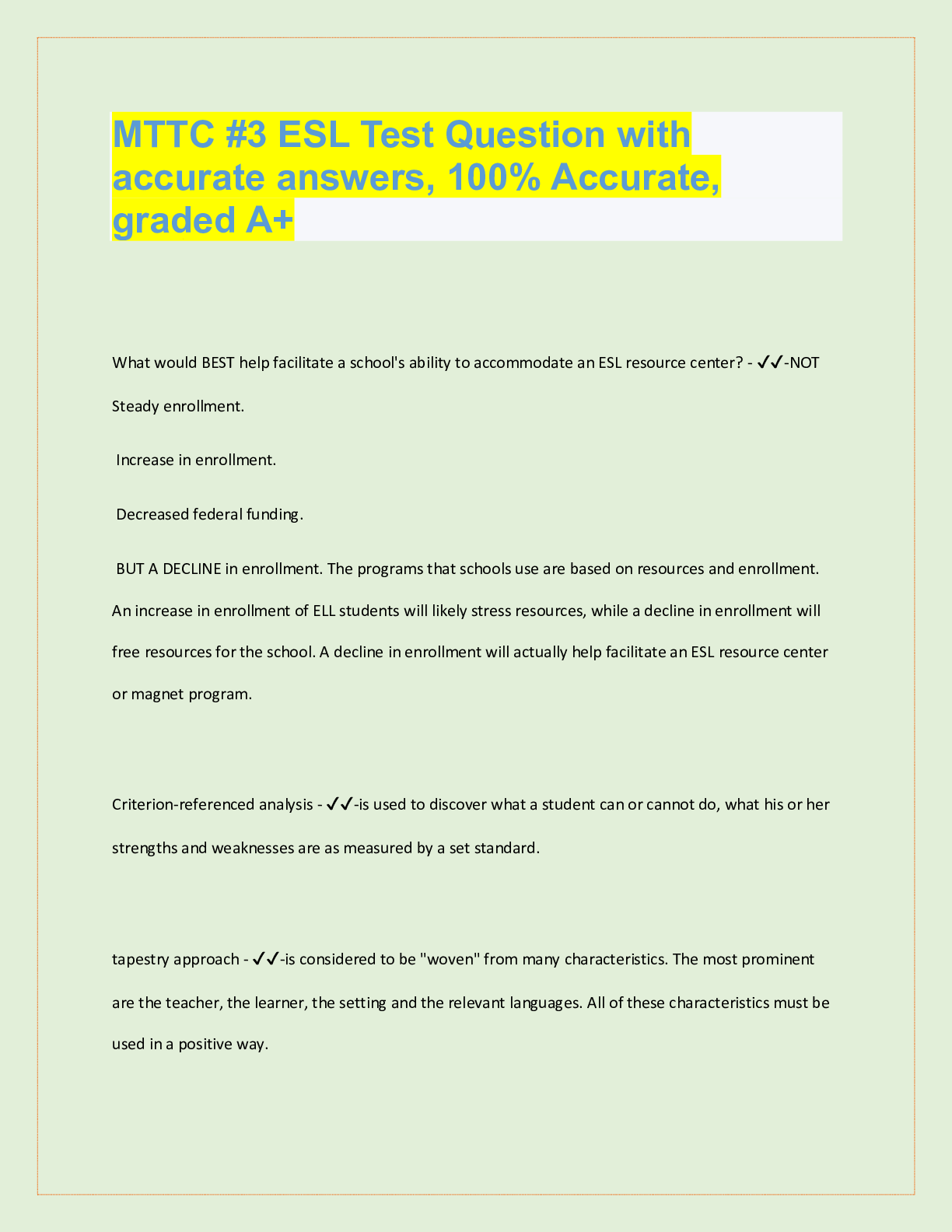
MTTC Practice BUNDLE, LATEST VERSIONS. EASY REVISION GUIDE.
MTTC Practice Questions & Answers, 100% Accurate, rated A+. Latest updates. Verified.
By Topmark 2 years ago
$32
10
Reviews( 0 )
$13.00
Can't find what you want? Try our AI powered Search
Document information
Connected school, study & course
About the document
Uploaded On
Mar 14, 2023
Number of pages
72
Written in
All
Additional information
This document has been written for:
Uploaded
Mar 14, 2023
Downloads
0
Views
135

